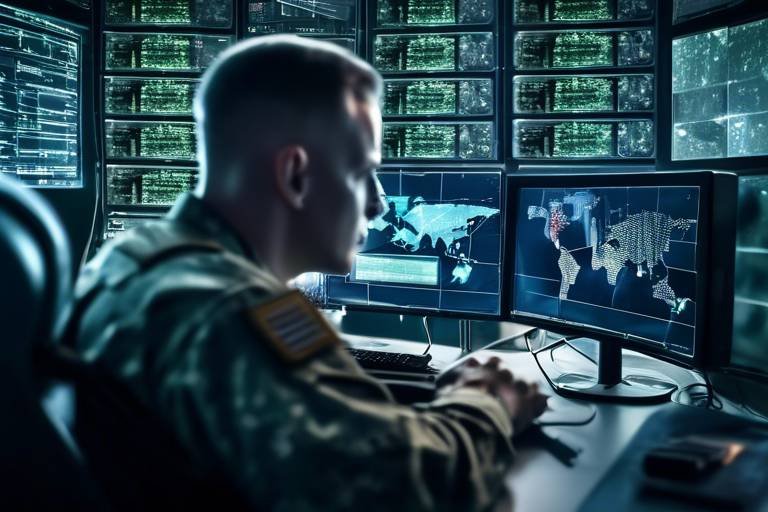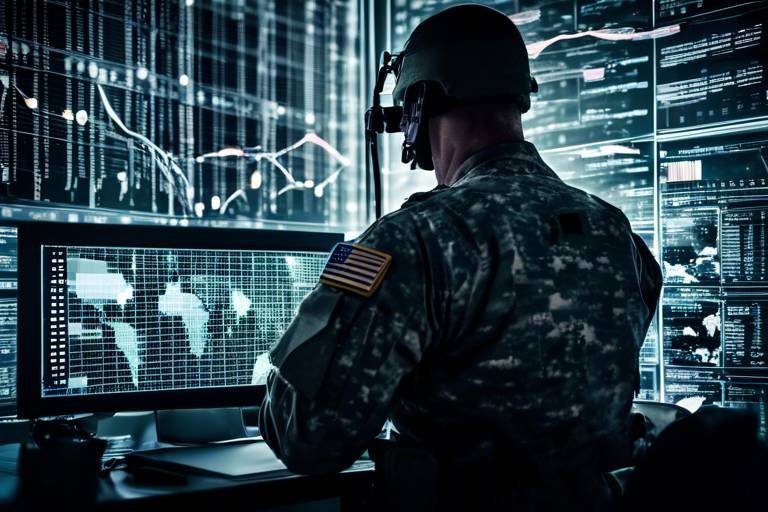The Importance of Cyber Hygiene in Modern Defense Systems
In an age where technology reigns supreme, the need for robust cybersecurity measures has never been more critical, especially in the realm of defense systems. Cyber hygiene is akin to personal hygiene; just as we wash our hands to prevent illness, we must also adopt practices that safeguard our digital environments. The implications of neglecting cyber hygiene can be catastrophic, leading to data breaches, loss of sensitive information, and even the compromise of national security. So, what exactly is cyber hygiene, and why is it so vital in modern defense systems?
Cyber hygiene encompasses a set of practices and routines that users engage in to maintain the health of their digital systems. This includes everything from regular software updates to recognizing phishing attempts. In defense systems, where the stakes are incredibly high, these practices can mean the difference between security and vulnerability. As cyber threats continue to evolve, the importance of maintaining rigorous cyber hygiene becomes even more pronounced.
Imagine a fortress that stands tall and proud, equipped with the latest technology and defenses. Now, picture that same fortress with a gaping hole in its wall, allowing intruders easy access. This is what neglecting cyber hygiene looks like in the digital world. Defense systems are the fortresses of our national security, and just like any fortress, they require constant vigilance and maintenance. By adopting a proactive approach to cyber hygiene, we can reinforce these defenses and ensure that our systems remain impervious to attacks.
Furthermore, the landscape of cyber threats is rapidly changing. With each passing day, hackers and malicious actors are developing more sophisticated methods to infiltrate systems. This means that defense organizations must not only stay informed about emerging threats but also continuously adapt their cyber hygiene practices. Regular audits, employee training, and an emphasis on security culture within organizations are essential components of this ongoing effort.
In conclusion, cyber hygiene is not just a technical necessity; it is a critical component of modern defense strategies. By prioritizing these practices, we ensure that our defense systems remain resilient against an ever-evolving threat landscape. The importance of cyber hygiene cannot be overstated; it is the foundation upon which our digital security is built.
- What is cyber hygiene? Cyber hygiene refers to the practices and steps taken to maintain system health and improve security, especially in defense systems.
- Why is cyber hygiene important for defense systems? It helps mitigate risks, protects sensitive information, and ensures the integrity of national security.
- What are some best practices for maintaining cyber hygiene? Regular software updates, employee training programs, and conducting security audits are key practices.
- What types of threats should defense systems be aware of? Malware, phishing scams, and insider threats are significant risks that defense systems must address.

Understanding Cyber Hygiene
Cyber hygiene is more than just a buzzword in today’s digital landscape; it’s a critical practice that every user of computers and devices must adopt to ensure the health and security of their systems. Think of it as the daily routine of washing your hands and brushing your teeth, but in the realm of cybersecurity. Just as these habits help prevent illness, maintaining good cyber hygiene is essential for mitigating risks associated with cyber threats, especially in sensitive areas like defense systems.
At its core, cyber hygiene encompasses a range of practices designed to keep systems secure and functioning optimally. This includes everything from regular software updates to password management and secure browsing habits. By adopting these practices, organizations can significantly reduce their vulnerability to cyber attacks. It's like putting on a seatbelt before driving; it’s a simple step that can save lives in the event of an accident.
One of the most important aspects of cyber hygiene is recognizing that the threat landscape is constantly evolving. New vulnerabilities and attack vectors emerge regularly, making it essential for organizations to stay informed and proactive. For instance, implementing multi-factor authentication is a simple yet effective way to enhance security. By requiring additional verification beyond just a password, organizations can add an extra layer of protection against unauthorized access.
Moreover, cyber hygiene is not just the responsibility of IT departments; it’s a collective effort that involves every employee. Imagine a team of soldiers preparing for battle; each member must be trained and aware of their role to ensure the unit's success. Similarly, every employee must be educated about potential threats and the importance of following security protocols. This includes recognizing phishing attacks, understanding the risks of using public Wi-Fi, and knowing how to handle sensitive information securely.
In summary, understanding and implementing cyber hygiene is vital for the integrity and security of defense systems. It’s about creating a culture of awareness and responsibility where everyone plays a part in protecting sensitive information. By prioritizing these practices, organizations can better defend against the ever-evolving threats in today’s digital world.

Threat Landscape in Defense Systems
The threat landscape for defense systems is like a constantly shifting battlefield, where new challenges emerge almost daily. As technology advances, so do the tactics employed by cybercriminals and nation-state actors. These threats are not just a nuisance; they can have profound implications on national security and operational integrity. Understanding this landscape is crucial for developing effective cyber hygiene practices that can safeguard sensitive information and critical infrastructure.
In today's world, where digital systems are intertwined with every aspect of defense operations, the potential for cyber attacks has skyrocketed. Cyber adversaries are becoming increasingly sophisticated, employing advanced techniques to exploit vulnerabilities. This evolution means that defense systems must remain vigilant and adaptable. Just as a soldier must be aware of the terrain in which they fight, cybersecurity professionals must be acutely aware of the various types of threats they face.
Some of the most prevalent threats include:
- Malware: This encompasses various malicious software designed to disrupt, damage, or gain unauthorized access to computer systems. Malware can cripple defense systems, making them vulnerable to further attacks.
- Phishing: Often described as the art of deception, phishing scams trick individuals into revealing sensitive information. These scams exploit human psychology, making them particularly dangerous.
- Insider Threats: Sometimes the biggest threat comes from within. Employees with access to sensitive information can inadvertently or intentionally compromise security.
As we delve deeper into these threats, it becomes evident that cybersecurity is not merely a technical issue; it's a human one as well. For instance, the human factor plays a significant role in both the success and failure of defense systems' cybersecurity measures. Training personnel to recognize potential threats is as critical as deploying the latest technology. Just like a soldier relies on their training to react in the heat of battle, cybersecurity staff must be equipped with the knowledge to identify and thwart attacks.
Moreover, the consequences of neglecting the evolving threat landscape can be catastrophic. A successful cyber attack can lead to data breaches, loss of sensitive information, and even disruption of military operations. The stakes are incredibly high, making it imperative for defense systems to implement robust security measures.
| Type of Threat | Description | Potential Impact |
|---|---|---|
| Malware | Malicious software designed to harm or exploit any programmable device. | Operational disruption, data loss, financial damage. |
| Phishing | Fraudulent attempts to obtain sensitive information by disguising as a trustworthy entity. | Data breaches, unauthorized access to systems. |
| Insider Threats | Threats posed by individuals within the organization, either maliciously or inadvertently. | Data leaks, sabotage, compromised security measures. |
In conclusion, the threat landscape in defense systems is complex and ever-changing. The need for proactive measures cannot be overstated. By understanding these threats and implementing effective cyber hygiene practices, defense systems can enhance their resilience against cyber attacks and safeguard national security.

Types of Cyber Threats
In today's digital battlefield, understanding the that can compromise defense systems is not just beneficial; it's essential. Imagine a fortress surrounded by walls, only to have the gates left unguarded. This analogy perfectly encapsulates the vulnerabilities that exist within our cyber defenses. Cyber threats can be broadly categorized into several types, each with its own unique characteristics and methods of attack. By recognizing these threats, defense systems can better prepare themselves to implement effective countermeasures.
One of the most notorious types of threats is malware. This term encompasses a range of malicious software designed to infiltrate and damage systems. Malware can take various forms, such as viruses, worms, and ransomware. For instance, ransomware can lock critical data and demand a hefty ransom for its release, effectively crippling operations. The impact of malware attacks can be devastating, leading to data breaches and operational disruptions. Therefore, robust measures must be in place to detect and prevent such infiltrations.
Another significant threat comes from phishing scams. These deceptive tactics exploit human psychology rather than technological vulnerabilities. Attackers often craft emails or messages that appear legitimate, tricking individuals into revealing sensitive information. Think of it as a wolf in sheep's clothing—on the surface, everything looks fine, but beneath lies a dangerous predator. Training personnel to recognize these scams is crucial; it’s akin to teaching soldiers to identify enemy disguises in the field. Regular training sessions can empower employees to spot red flags, such as suspicious URLs or unexpected attachments, which can significantly reduce the risk of falling victim to phishing attempts.
Lastly, we cannot overlook the threat posed by insider threats. These threats can often go unnoticed because they originate from within the organization itself. Employees, whether maliciously or unintentionally, can compromise sensitive information or systems. It's like having a spy within the ranks—someone who knows the ins and outs of the defenses. To combat this, implementing strict access controls and monitoring systems is essential. By limiting access based on necessity and continually auditing user activities, organizations can mitigate the potential damage caused by insider threats.
In summary, the threat landscape is diverse and constantly evolving. From malware to phishing and insider threats, each type poses unique challenges that require tailored defense strategies. Understanding these threats is the first step toward building a resilient defense system capable of withstanding the onslaught of cyber attacks.
- What is cyber hygiene? Cyber hygiene refers to the practices and steps taken to maintain system health and improve security.
- How can I protect against phishing scams? Regular training and awareness programs can help individuals recognize and avoid phishing attempts.
- What are insider threats? Insider threats come from individuals within the organization who may intentionally or unintentionally compromise security.
- Why are regular software updates important? Keeping software updated ensures that systems are protected against known vulnerabilities.

Malware Attacks
In the realm of cybersecurity, are like the proverbial wolf in sheep's clothing, lurking in the shadows, ready to pounce on unsuspecting victims. These malicious software programs can wreak havoc on defense systems, causing not only operational disruptions but also the potential compromise of sensitive information. Imagine a well-oiled machine suddenly grinding to a halt because a tiny piece of code slipped through the cracks. That's the reality of malware attacks.
Malware comes in various forms, each designed with a specific purpose, whether it's to steal data, disrupt services, or even gain unauthorized access to secure networks. The most common types of malware include:
- Viruses: These are self-replicating programs that attach themselves to clean files and spread throughout a system.
- Worms: Unlike viruses, worms can spread independently, often exploiting vulnerabilities in the software.
- Trojan Horses: These disguise themselves as legitimate software to trick users into downloading them.
- Ransomware: A particularly nasty type of malware that locks users out of their systems until a ransom is paid.
To combat these threats, defense systems must adopt a multi-layered approach to cybersecurity. This includes employing robust measures such as:
- Real-time monitoring: This allows for the immediate detection of suspicious activities and potential breaches.
- Advanced threat detection systems: Utilizing AI and machine learning can help identify unusual patterns that may indicate a malware attack.
- Regular security audits: These can reveal vulnerabilities that need addressing before they are exploited.
Moreover, it’s crucial to foster a culture of cybersecurity awareness among all personnel. Regular training sessions can empower employees to recognize the signs of malware and take appropriate action. After all, the human element is often the weakest link in the security chain. By equipping everyone with knowledge, organizations can significantly reduce the risk of malware infiltrating their defense systems.
In conclusion, malware attacks are a persistent threat that can have devastating consequences for defense systems. By understanding the nature of these threats and implementing comprehensive security measures, organizations can better safeguard their critical infrastructure. As the saying goes, "an ounce of prevention is worth a pound of cure," and in the world of cybersecurity, this couldn’t be more true.
- What is malware? Malware is malicious software designed to disrupt, damage, or gain unauthorized access to computer systems.
- How can I protect my system from malware? Regular software updates, using antivirus programs, and employee training are effective ways to protect against malware.
- What should I do if I suspect a malware attack? Immediately disconnect from the network, run a full system scan with antivirus software, and report the incident to your IT department.

Phishing Scams
Phishing scams are a deceptive tactic used by cybercriminals to trick individuals into revealing sensitive information, such as usernames, passwords, and credit card details. These scams often masquerade as legitimate communications from trusted sources, such as banks, government agencies, or even colleagues within an organization. Imagine receiving an email that looks just like it came from your bank, urging you to click on a link to verify your account details. It’s easy to see how someone could fall victim to such a well-crafted scheme.
One of the most alarming aspects of phishing is its ability to exploit human psychology. Cybercriminals often create a sense of urgency or fear, compelling individuals to act quickly without thinking critically. For instance, a phishing email might state that your account will be suspended unless you verify your information immediately. This tactic plays on our instinct to protect ourselves, making it crucial for defense systems to train personnel on recognizing these threats.
To effectively combat phishing scams, organizations should implement a multi-layered approach that includes:
- Employee Training: Regular training sessions can help employees identify suspicious emails and understand the importance of verifying the source before clicking on any links.
- Simulated Phishing Attacks: Conducting mock phishing exercises can provide employees with hands-on experience, allowing them to practice identifying phishing attempts in a safe environment.
- Advanced Email Filtering: Utilizing advanced email filtering technologies can help detect and block phishing emails before they reach the inbox.
Furthermore, organizations should encourage a culture of open communication, where employees feel comfortable reporting suspicious emails or activities without fear of repercussions. This proactive approach can significantly enhance an organization’s cyber hygiene and resilience against phishing scams.
In summary, phishing scams are a pervasive threat that requires constant vigilance and education. By making cybersecurity awareness a priority and implementing robust training programs, defense systems can better protect themselves against these deceptive tactics. Remember, in the world of cybersecurity, a well-informed employee is often the first line of defense.
- What is phishing? Phishing is a cyber attack where attackers impersonate legitimate organizations to steal sensitive information from victims.
- How can I recognize a phishing email? Look for unusual sender addresses, poor spelling and grammar, and unexpected requests for sensitive information.
- What should I do if I receive a phishing email? Do not click on any links or download attachments. Report the email to your IT department or email provider.

Insider Threats
When we think about cybersecurity threats, our minds often jump to external hackers or sophisticated malware. However, one of the most insidious and challenging threats comes from within: the insider threat. These threats can arise from employees, contractors, or anyone with trusted access to sensitive information and systems. The reality is that insiders can either be malicious actors seeking to exploit their access or simply careless individuals whose actions inadvertently compromise security. This duality makes insider threats particularly tricky to manage.
Insider threats can manifest in various forms, including data theft, sabotage, or unintentional breaches. For example, a disgruntled employee might intentionally leak classified information to a competitor, while a well-meaning worker could accidentally send sensitive data to the wrong email address. The consequences of such actions can be devastating, leading to financial loss, reputational damage, and even national security risks. Understanding the motivations behind these threats is crucial for developing effective countermeasures.
To combat insider threats, organizations must implement a multi-layered approach that includes:
- Strict Access Controls: Limiting access to sensitive information based on the principle of least privilege ensures that individuals only have access to the data necessary for their roles.
- Continuous Monitoring: Regularly monitoring user activity can help detect unusual behavior that may indicate a potential insider threat.
- Employee Training: Educating employees about the importance of cybersecurity and the potential consequences of their actions is vital. Awareness programs can empower staff to recognize and report suspicious activities.
Additionally, organizations should foster a culture of security where employees feel comfortable reporting concerns without fear of retribution. This open dialogue can be key in identifying potential threats before they escalate. Furthermore, conducting regular audits and assessments of security protocols will help ensure that defenses are robust and up-to-date.
In summary, while insider threats may be less visible than external attacks, they are equally dangerous and require a proactive approach to manage effectively. By implementing stringent security measures, fostering a culture of awareness, and maintaining continuous vigilance, defense systems can significantly mitigate the risks posed by insiders.
Q1: What are insider threats?
Insider threats are security risks that originate from within an organization, involving individuals who have inside information concerning the organization's security practices, data, and computer systems. They can be malicious or unintentional.
Q2: How can organizations protect against insider threats?
Organizations can protect against insider threats by implementing strict access controls, conducting continuous monitoring, providing employee training, and fostering a culture of security awareness.
Q3: Are insider threats more dangerous than external threats?
While both insider and external threats pose significant risks, insider threats can be particularly dangerous due to the trusted access insiders have to sensitive information and systems, making them harder to detect.

Best Practices for Cyber Hygiene
Maintaining robust cyber hygiene is not just a good practice; it's a necessity in today's digital landscape, especially for defense systems. Think of cyber hygiene as a daily routine, similar to brushing your teeth or locking your doors. Just as you wouldn’t skip these routines, you shouldn’t overlook the essential steps needed to secure your digital environment. Implementing best practices for cyber hygiene ensures that your systems remain resilient against threats and vulnerabilities.
One of the most critical aspects of cyber hygiene is regular software updates. Outdated software is like leaving your front door wide open; it invites unwanted guests. Cybercriminals are always on the lookout for vulnerabilities in software, and when updates are not applied, they find easy targets. Regularly updating your software not only patches known vulnerabilities but also enhances functionality and performance. It’s advisable to set reminders or automate updates whenever possible, ensuring that your systems are always equipped with the latest security measures.
Another key practice involves employee training programs. Imagine your employees as the first line of defense; if they are not adequately trained, it’s like sending soldiers into battle without weapons. Cybersecurity awareness training equips your personnel with the knowledge they need to recognize potential threats. For instance, phishing scams can be particularly insidious, exploiting human vulnerabilities. Regular training sessions can help employees identify suspicious emails or links, significantly reducing the chances of a successful attack.
In addition to these practices, conducting regular audits of your systems is essential. Think of audits as health check-ups for your cybersecurity posture. They help identify weaknesses and areas for improvement. During an audit, you can assess whether your current policies and procedures are effective or need adjustments. This proactive approach ensures that you are not only reacting to threats but also anticipating them.
Moreover, establishing strict access controls is crucial in mitigating insider threats. Insider threats can often be overlooked because they come from within the organization. By limiting access to sensitive information and systems based on the principle of least privilege, you can significantly reduce the risk of unauthorized access. It’s like giving out keys to your house only to those who truly need them. Regularly reviewing access permissions ensures that only the right people have access to critical systems.
Lastly, consider implementing multi-factor authentication (MFA) as an additional layer of security. MFA acts as a safety net, making it significantly harder for unauthorized users to gain access to your systems. Even if a password is compromised, MFA requires additional verification, such as a code sent to a mobile device or a biometric scan. This extra step can deter cybercriminals and enhance the overall security of your defense systems.
In summary, best practices for cyber hygiene are vital for safeguarding defense systems against evolving threats. By prioritizing regular software updates, conducting employee training, performing audits, enforcing access controls, and utilizing multi-factor authentication, you can create a robust defense against potential cyber threats. Remember, in the world of cybersecurity, an ounce of prevention is worth a pound of cure!
- What is cyber hygiene? Cyber hygiene refers to the practices and steps taken to maintain system health and improve security.
- Why are regular software updates important? They protect against vulnerabilities and ensure systems are equipped with the latest security patches.
- How can employee training reduce cyber risks? Training helps employees recognize and respond to potential threats, reducing the likelihood of successful attacks.
- What role do audits play in cyber hygiene? Audits help identify weaknesses and ensure that policies and procedures are effective in protecting systems.
- What is multi-factor authentication? MFA is an additional security layer requiring multiple forms of verification for access to systems.

Regular Software Updates
In the fast-paced world of cybersecurity, are not just a good practice; they are a necessity. Think of software updates as the armor that protects your defense systems from the ever-evolving threats lurking in the digital shadows. Just like you wouldn’t leave your home without locking the doors, you shouldn’t leave your systems vulnerable by neglecting updates. The reality is that cybercriminals are constantly searching for weaknesses in software, and outdated systems are like open invitations for them to exploit.
Software updates often come packed with essential security patches designed to close vulnerabilities that hackers might exploit. For instance, when a new vulnerability is discovered, software developers work tirelessly to create a patch—essentially a fix that fortifies the software against potential attacks. By neglecting to install these updates, you’re essentially leaving a backdoor open for intruders. It’s crucial to establish a routine for checking and applying updates, whether they are automatic or manual. Here’s why:
- Protection Against Exploits: Each update is a step towards safeguarding your systems. They help in fixing known vulnerabilities before they can be exploited.
- Enhanced Features: Updates often include new features and improvements that can enhance the functionality and efficiency of your systems.
- Compliance: Many defense systems are subject to regulatory requirements. Keeping software updated helps ensure compliance with these regulations.
In addition to security patches, updates can also include performance enhancements that improve the overall efficiency of your systems. Imagine running a marathon with a pair of outdated shoes—eventually, they’ll hold you back. Similarly, outdated software can slow down operations, making it difficult for defense systems to function at their best. Therefore, it’s not just about security; it’s about performance too.
To make the process easier, consider implementing a centralized update management system. This allows you to track and manage updates across all devices within your defense systems seamlessly. You can schedule updates during off-peak hours to minimize disruption, ensuring that your operations remain smooth and uninterrupted. Remember, the key is consistency. Just like brushing your teeth every day keeps your smile bright, regular updates keep your systems healthy and secure.
In conclusion, prioritizing regular software updates is a fundamental aspect of maintaining robust cyber hygiene. It’s about creating a proactive culture where security is at the forefront of every operation. By committing to regular updates, you’re not just protecting your systems; you’re investing in the future integrity of your defense mechanisms. So, take that step today—don’t let your systems fall behind in the ever-evolving battle against cyber threats.
- Why are regular software updates important? Regular updates are crucial for fixing vulnerabilities, enhancing performance, and ensuring compliance with security standards.
- How can I ensure my software is always up to date? Implementing a centralized update management system can help automate the process and keep track of updates across all devices.
- What happens if I don’t update my software? Neglecting updates can leave your systems vulnerable to cyber attacks, potentially leading to data breaches and operational disruptions.

Employee Training Programs
In the ever-evolving landscape of cybersecurity, are not just an option; they are a necessity. Imagine a ship sailing through treacherous waters without a crew trained in navigation and safety protocols. That ship is likely to encounter disaster. Similarly, defense systems without well-informed personnel are at a significant risk of cyber threats. Training programs should be designed to equip employees with the knowledge and skills they need to recognize and respond effectively to potential cyber threats.
These programs should cover a variety of topics, including:
- Recognizing Phishing Attempts: Employees must learn to identify suspicious emails and links that may lead to malware or data breaches.
- Understanding Malware: Training should provide insights into different types of malware and how they can infiltrate systems.
- Safe Internet Practices: Employees should be educated on safe browsing habits and the importance of using secure networks.
- Incident Reporting: Staff should know the proper protocols for reporting suspicious activities or potential breaches.
Moreover, these training sessions should not be one-off events. Just like any skill, cybersecurity awareness needs to be reinforced regularly. Organizations should implement a schedule for refresher courses and updates on the latest threats. This not only keeps the knowledge fresh but also fosters a culture of cyber vigilance within the organization.
To further enhance the effectiveness of training programs, utilizing interactive methods can be beneficial. For instance, incorporating simulations of phishing attacks can provide employees with hands-on experience in recognizing and reacting to threats. Such practical exercises can significantly boost confidence and competence in handling real-world scenarios.
Additionally, measuring the effectiveness of these training programs is crucial. Organizations can conduct assessments and surveys post-training to gauge the retention of knowledge and identify areas needing improvement. This iterative approach ensures that the training evolves alongside emerging threats, making it a dynamic component of the overall cybersecurity strategy.
In conclusion, employee training programs are the backbone of a robust cybersecurity defense. By investing in these programs, organizations not only protect their assets but also empower their workforce to be the first line of defense against cyber threats.
- What is the main goal of employee training programs in cybersecurity?
The primary goal is to educate employees on recognizing and responding to potential cyber threats, thereby reducing the risk of breaches. - How often should training be conducted?
Regular training sessions should be held, ideally quarterly, with refresher courses as needed to keep employees updated on the latest threats. - Are interactive training methods more effective?
Yes, interactive methods, such as simulations and hands-on exercises, tend to engage employees better and enhance retention of information. - How can organizations measure the effectiveness of their training programs?
Organizations can use assessments, surveys, and incident reports to evaluate the knowledge retention and application of skills learned during training.
Frequently Asked Questions
- What is cyber hygiene?
Cyber hygiene refers to the practices and steps that users of computers and devices take to maintain system health and improve security. It's like brushing your teeth daily to prevent cavities; consistent care helps keep your systems safe from cyber threats.
- Why is cyber hygiene important for defense systems?
Cyber hygiene is crucial for defense systems because it helps mitigate risks associated with increasingly sophisticated cyber attacks. Just as a well-maintained vehicle is less likely to break down, a system with good cyber hygiene is more resilient against breaches and disruptions.
- What are some common types of cyber threats?
Common types of cyber threats include malware, phishing scams, and insider threats. Each of these can compromise sensitive data and disrupt operations, making it essential to recognize and address them proactively.
- How can malware attacks be prevented?
To prevent malware attacks, defense systems should implement robust measures such as regular software updates, firewalls, and antivirus programs. Think of these measures as the locks on your doors; they help keep unwanted intruders out.
- What is phishing and how can it be avoided?
Phishing is a type of cyber attack that exploits human vulnerabilities to gain unauthorized access to systems. It can be avoided by training personnel to recognize suspicious emails and links, much like teaching someone to spot a counterfeit bill.
- What are insider threats and how can they be mitigated?
Insider threats come from individuals within an organization who may misuse their access to compromise security. Mitigating these threats involves implementing strict access controls and continuous monitoring, akin to having security cameras in a store to deter theft.
- What best practices should be followed for effective cyber hygiene?
Best practices for effective cyber hygiene include regular software updates, employee training programs, and conducting audits. These practices ensure that everyone is aware of potential threats and that systems are always equipped with the latest defenses.
- How often should software updates be performed?
Software updates should be performed regularly, ideally as soon as patches are released. This is similar to getting regular check-ups at the doctor; timely updates can prevent larger issues down the line.
- What role does employee training play in cyber hygiene?
Employee training is vital in cyber hygiene because it educates personnel on recognizing threats and responding appropriately. Just as a fire drill prepares people for emergencies, cybersecurity training prepares employees to handle potential cyber incidents effectively.



















